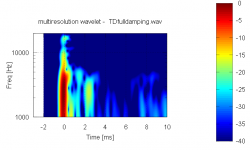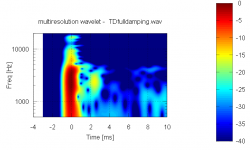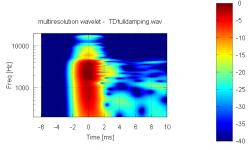After over 7000 posts there's little that can be considered off the topic(s) of this thread.
Few
LOL - "Beyond OT"
-----------
We possibly can summarize the steady state issue simple :
IR (as the time domain aquivalent of FR) is the „matrix“ to determine how input signals get deformed *and also* FR (as frequency domain aquivalent to IR) is the end result of that transformation process (input > output) we would hear „SPL wise“ after infinite time = steady state.
So we are running a little bit in circles here.
I guess thats been what Elias was focusing on.
I'm definitely with him that the steady state SPL plots do not sufficiently tell us what we "hear" - given the dynamic structure music distinguishes from "steady state". It needs some additional "reading the tea leaves" to get a good grip on the time behaviour with only a FR plot at hand - Time-freqency plots are IMO more intuitively to read in this respect.
The topic IMO is interesting in so far, as CMP can be seen to reach „steady state“ immediately – immediately at „time = zero“ and for the second part at exactly „time = time delay“ - and lastly for the "tail" as well
Which is untypical for any other time dependent variations in SPL (= resonance)
Besides that – and also to come back closer to the threads topic – I guess the most interest would be in how would a „as good as it gets“ EQ'ing of CMP look like – respectively – what are the artifacts of CMP distortion left.
Possibly - *if* we consider the 2.3 ms wiggle as a pure and simple reflection somewhere in the TD15M driver (which in reality most likely isnt *that* simple, but just for the sake of simplicity) - we could hypothesize a „as good as it gets“ EQ'ing and then check how the remaining CMP distortion possibly looks like ???
Michael
Last edited:
So, after all this discussion (interesting as it is), has anyone bothered to get a strobe and look at the spider to see if it is the source of the 2.3ms wiggle?
Did anyone else explain the polarity inversion of the pulse?
Tonebursts at 2.3ms intervals could be revealing.
Mike
Did anyone else explain the polarity inversion of the pulse?
Tonebursts at 2.3ms intervals could be revealing.
Mike
I was under the impression that there was no intension to tweek the driver.
Good point. Anyway, here's a particular post that may or may not be relevant: http://www.diyaudio.com/forums/multi-way/103872-geddes-waveguides-219.html#post1749366
I think someone mentioned that possibility a few pages back. I was wondering whether that could happen to a spider at 2KHz or not. The only way to find out is to tweek it.
Heh, guess I was echoing my own comment.
The frequencies contained within the wave packet could be as high as 2kHz.
Group velocity - Wikipedia, the free encyclopedia
Wouldn't it be cool if it was a physical manifestation of a de Broglie wave?
The impulse does not show that occuring.
True. Sorry, I got carried away. I still have a lot to learn.
Thanks for your replies!
Best regards,
Mike
In the limit an infinitesimally short sweep is an impulse, and I think we know the term used for the output of a system when driven by an impulse. Perhaps you are aware that sweeps are also referred to as "time stretched pulses", particularly amongst Japanese researchers, and the motivation for their use is to spread the energy of the impulse out in time so that the total energy delivered is far greater than the system could cope with if an impulse were used directly. Or perhaps not.To be accurate, log sweep cannot measure system's impulse response. Not unless you start the sweep from DC. But one cannot do that because it would take infinite time to play the sweep. Anything else yields only approximation of the impulse response. In practise approximations are often sufficient, but it does not remove the (approximate) steady state condition requirement. The more 'steady stateiness' in the log sweep the more accurate is the measured impulse response. That is, the longer the sweep the more accurate is the impulse response. To understand this try to think what will happen if you make your log sweep infinitesimally short in duration.
Hello,
Here's some more wavelets on TD15 impulse response posted earlier. This is the "full damping" case. There are three transforms of different wavelet lengths of 1ms, 2ms and 5ms. These are non-normalised so amplitude information is true. Also notice that the frequency axes have different scales.
From 1ms wavelet one can see energy is packed at 2.5ms. But there are things happening before 2ms also.
In 5ms wavelet the direct sound and the energy at 2.5ms are overlapping and comb filtering occurs. These is mostly visible at 2ms and between 2-4kHz.

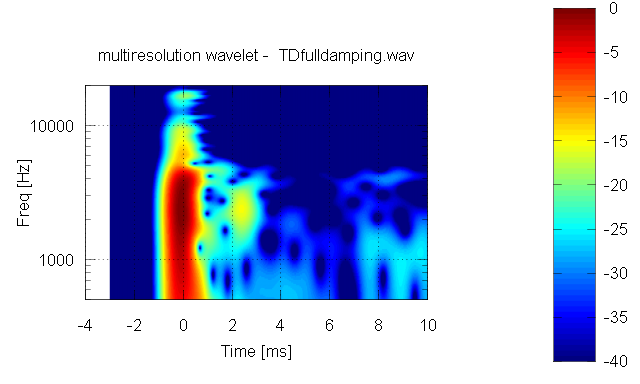
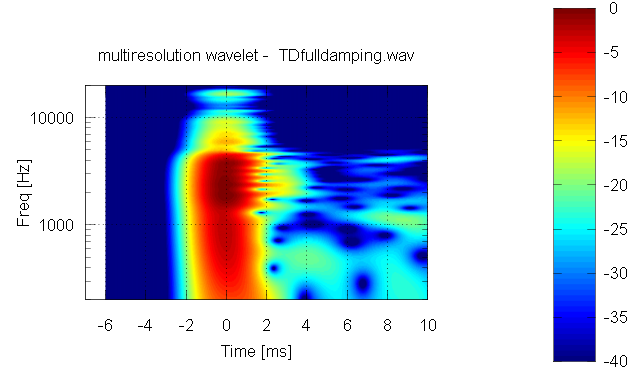
It seems clear to me that the energy at 2.5ms is cabinet reflections/diffractions. Maybe that was obvious already
Here's some more wavelets on TD15 impulse response posted earlier. This is the "full damping" case. There are three transforms of different wavelet lengths of 1ms, 2ms and 5ms. These are non-normalised so amplitude information is true. Also notice that the frequency axes have different scales.
From 1ms wavelet one can see energy is packed at 2.5ms. But there are things happening before 2ms also.
In 5ms wavelet the direct sound and the energy at 2.5ms are overlapping and comb filtering occurs. These is mostly visible at 2ms and between 2-4kHz.



It seems clear to me that the energy at 2.5ms is cabinet reflections/diffractions. Maybe that was obvious already
Attachments
I don't know what is your position but nothing you have said so far changes the fact that "frequency response" indicates system's response at steady state. This is what I said in the beginning and you opposed.
- Elias
- Elias
In the limit an infinitesimally short sweep is an impulse, and I think we know the term used for the output of a system when driven by an impulse. Perhaps you are aware that sweeps are also referred to as "time stretched pulses", particularly amongst Japanese researchers, and the motivation for their use is to spread the energy of the impulse out in time so that the total energy delivered is far greater than the system could cope with if an impulse were used directly. Or perhaps not.
One measurement I would like to see is to place the two enclosures back to back and feed the signal only to the front one as before. This would propably remove the diffraction at 2.5ms and place it further in time domain. Just to validate (by direct comparision) that the 2.5ms really is from the cabinet.
- Elias
- Elias
Elias my tests of the AE drivers were on an open baffle, so there was no rear wall reflection.
From John J's comments I take it that this is a suspension or cone issue. It is not as noticeable with the fabric surrounds, although it is still there. It is also most noticeable on the 15" drivers. My guess is it is cone/surround interface issue. Similar to the dip you see around 800-1000hz, on smaller drivers, especially 8" woofers for whatever reason. Or cone flex issue that is mitigated by fabric surrounds but not helped by foam surrounds.
Anyway I haven't seen any big woofers with better IR than the AE drivers so not sure what the fuss is about.
From John J's comments I take it that this is a suspension or cone issue. It is not as noticeable with the fabric surrounds, although it is still there. It is also most noticeable on the 15" drivers. My guess is it is cone/surround interface issue. Similar to the dip you see around 800-1000hz, on smaller drivers, especially 8" woofers for whatever reason. Or cone flex issue that is mitigated by fabric surrounds but not helped by foam surrounds.
Anyway I haven't seen any big woofers with better IR than the AE drivers so not sure what the fuss is about.
Elias my tests of the AE drivers were on an open baffle, so there was no rear wall reflection.
Same here. I tested without the cabinet, and the 2.5 ms wrinkle was still there.
Anyway I haven't seen any big woofers with better IR than the AE drivers so not sure what the fuss is about.
My feelings exactly! Judging by the results, I'm pretty sure that Nick McKinney worked hard to chase out every problem he could while developing this driver.
All of the 15" drivers I have used have brought a certain quality (solidity, authority) to the presentation that I really like. As with everything else in speaker design, there are compromises as well. The TD15M doesn't measure as cleanly as the little Vifa drivers in the Ariel, but its strengths are obviously different.
As much as I have liked the other 15" drivers I have used (Altec 416, 515, 604, Klipsch K-48), I don't expect the TD15M will be a disappointment.
Of course I am curious about the cause of the 2.5 ms ripple, but I have less than two weeks remaining before starting back to work, and need to focus on completing the crossovers.
Gary Dahl
I was under the impression that there was no intension to tweek the driver.
Gary did say he was not interested in modifying the driver. However, if simple reversible damping could be applied to the spider (assuming that's indeed the source of the reflection/resonance), then he or others might try it. But not much point until it's determined that the phenomenon is an audible issue in the given application. I have 15" Lambda TDX (Apollo motor) in my system. Since I cross them around 400Hz, I'm not much motivated to experiment. John at AE might be interested in mitigating this issue, especially since these drivers do have extended frequency response.
Sheldon
Elias, without in any way wishing to appear rude, that is a meaningless statement. The system's frequency response and impulse response are interchangeable, they both describe the same system and how it affects signals that pass through it. Would your statement make sense to you if it read "the impulse response indicates the system's response at steady state"? There seems to be a continual confusion between the system's frequency response, which is an invariant property of the system, and the spectrum of the system's output and/or the spectrum of segments of the system's impulse response as it evolves over time. They are not the same thing.I don't know what is your position but nothing you have said so far changes the fact that "frequency response" indicates system's response at steady state. This is what I said in the beginning and you opposed.
Hi,
EE102: Introduction to Signals & Systems
Chapter 10: "Sinusoidal steady-state and frequency response"
http://www.stanford.edu/~boyd/ee102/freq.pdf
EE102: Introduction to Signals & Systems
Chapter 10: "Sinusoidal steady-state and frequency response"
http://www.stanford.edu/~boyd/ee102/freq.pdf
"frequency response" indicates system's response at steady state.
that is a meaningless statement.
Nice to see where your misunderstanding has come from Elias, but unfortunately you have things back to front. The response to a sinusoid, just like the response to any input, is determined by the frequency response (including the transient behaviour). The frequency response is not determined by hanging around for the transients of applying an infinity of sinusoids to decay.Hi,
EE102: Introduction to Signals & Systems
Chapter 10: "Sinusoidal steady-state and frequency response"
http://www.stanford.edu/~boyd/ee102/freq.pdf
- Home
- Loudspeakers
- Multi-Way
- Beyond the Ariel
